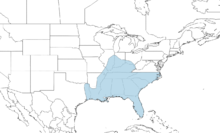Rafinesque's big-eared bat
Rafinesque's big-eared bat (Corynorhinus rafinesquii) is a type of vesper bat. It is sometimes called the southeastern big-eared bat. It is native to the southeastern United States.
| Rafinesque's big-eared bat | |
|---|---|

| |
| Scientific classification | |
| Domain: | Eukaryota |
| Kingdom: | Animalia |
| Phylum: | Chordata |
| Class: | Mammalia |
| Order: | Chiroptera |
| Family: | Vespertilionidae |
| Genus: | Corynorhinus |
| Species: | C. rafinesquii
|
| Binomial name | |
| Corynorhinus rafinesquii Lesson, 1827
| |

| |
| Species distribution (in the southeastern United States) based on data from the IUCN. | |
| Synonyms | |
|
Plecotus rafinesquii | |
Description
changeRafinesque's big-eared bat is around 7.5–10 cm (3.0–3.9 in) long. It has a wingspan of 25–30 cm (10–12 in). They weigh from 6–13 g (0.21–0.46 oz). The bat is gray on the dorsal side and white on the underside. The ears and face are a pinkish-brown color, while the arm and wing are dark brown.[2]
Distribution and Habitat
changeIt is found in the southeastern United States. It lives in many habitats from coastal plains and riparian areas to mountainous areas such as the Great Smoky Mountains National Park.[3]
Feeding
changeRafinesque's big-eared bats are insectivorous. They are nocturnal animals. They find food mainly by echolocation. They eat lots of different kinds of insects.[4]
References
change- ↑ Arroyo-Cabrales, J. & Ticul Alvarez Castaneda, S (2008). "Corynorhinus rafinesquii". IUCN Red List of Threatened Species. 2008. Retrieved 1 February 2010.
- ↑ Titus, Keifer. "Corynorhinus rafinesquii (Rafinesque's big-eared bat)". Animal Diversity Web. Retrieved 2020-10-25.
- ↑ Noroeste), Sergio Ticul Álvarez-Castañeda (Centro de Investigaciones Biológicas del; Arroyo-Cabrales, J. (2016-08-26). "IUCN Red List of Threatened Species: Corynorhinus rafinesquii". IUCN Red List of Threatened Species. Retrieved 2020-10-25.
- ↑ J, Lacki Michael; Ladeur, Kristina M. (2001). "Seasonal Use of Lepidopteran Prey by Rafinesque's Big-eared Bats (Corynorhinus rafinesquii)". The American Midland Naturalist. 145 (1): 213–217. doi:10.1674/0003-0031(2001)145[0213:SUOLPB]2.0.CO;2. ISSN 0003-0031. S2CID 85723602.
